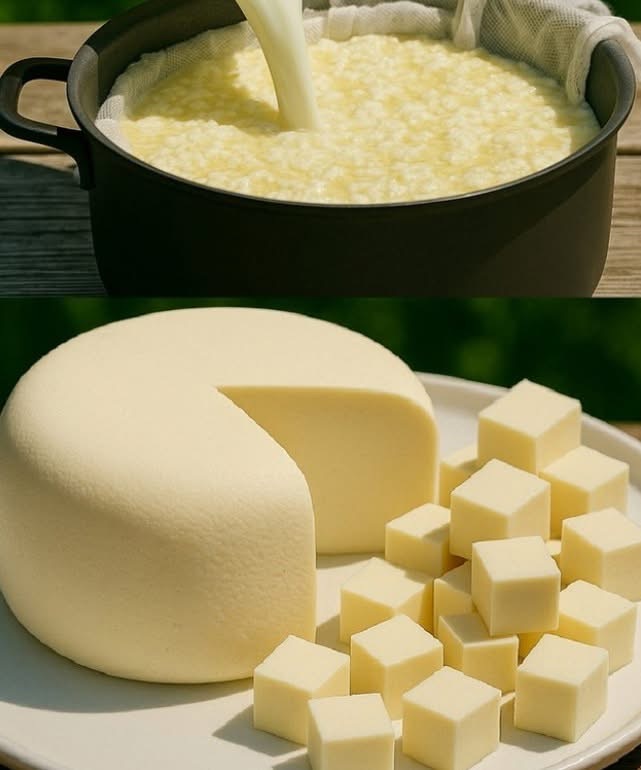
Introduction
Cheese is one of the oldest and most loved dairy products in the world. From ancient farmers who first discovered curdled milk, to modern kitchens where we craft creamy delights, cheese-making has been an art of transformation. This recipe will teach you how to make fresh cheese at home—soft, smooth, and perfect for cutting into cubes, crumbling over salads, or cooking into curries and casseroles.
Ingredients
- 2 liters (8 cups) full-fat whole milk
- 4–5 tablespoons lemon juice (or white vinegar)
- 1 teaspoon salt (optional, for flavor)
- Cheesecloth or a clean cotton towel
- Cold water
Instructions
- Heat the Milk
- Pour the milk into a heavy-bottomed pot.
- Heat gently over medium flame until it begins to steam and small bubbles form along the edges (about 85–90°C / 185–195°F).
- Add the Acid
- Slowly pour in the lemon juice or vinegar while stirring gently.
- The milk will curdle, separating into white curds (solid) and yellowish whey (liquid).
- Rest the Curds
- Remove from heat and let the mixture sit for 10 minutes, allowing the curds to firm up.
- Strain the Curds
- Place a cheesecloth over a colander and pour the mixture through it.
- Collect the whey (it can be used later in soups, smoothies, or bread dough).
- Rinse & Press
- Rinse the curds under cold water to remove the acidic taste.
- Gather the cheesecloth into a bundle and gently squeeze out excess water.
- Place it on a flat surface, put a heavy object on top (like a pan or jar), and press for 1–2 hours.
- Cut & Serve
- Once firm, unwrap your cheese.
- Slice into cubes, rounds, or crumble as desired.
Methods of Enjoying Fresh Cheese
- Indian Paneer: Cut into cubes and use in curries like Palak Paneer or Paneer Butter Masala.
- Farmer’s Cheese: Crumble over salads, pastas, or baked dishes.
- Grilled: Pan-fry or grill cubes with spices for a smoky flavor.
- Sweet: Mix with sugar and cardamom to create Indian sweets like Rasgulla or Sandesh.
History
Cheese dates back over 7,000 years, with origins in Mesopotamia and the Middle East. Ancient shepherds discovered that milk stored in animal stomachs (containing natural rennet) would curdle, creating cheese. Fresh cheeses like this recipe are among the oldest forms of cheese, simple yet timeless.
Benefits
- High in Protein: Supports muscle repair and strength.
- Rich in Calcium: Essential for strong bones and teeth.
- Low in Carbs: Great for keto or low-carb diets.
- Versatile: Can be used in both sweet and savory dishes.
- Digestive Aid: The whey byproduct is probiotic-rich.
Formation Process Summary
- Milk heated →
- Acid added →
- Curds separate from whey →
- Curds strained →
- Pressed into block →
- Ready-to-use cheese!
Nutrition (per 100g serving)
- Calories: ~265 kcal
- Protein: 18 g
- Fat: 20 g
- Carbohydrates: 2 g
- Calcium: 200 mg
Conclusion
Making fresh cheese at home is easy, rewarding, and healthier than store-bought. With just milk and lemon juice, you can create a creamy, delicious cheese that elevates any meal. Whether you’re a cheese lover craving authenticity or someone seeking healthier alternatives, this recipe delivers.